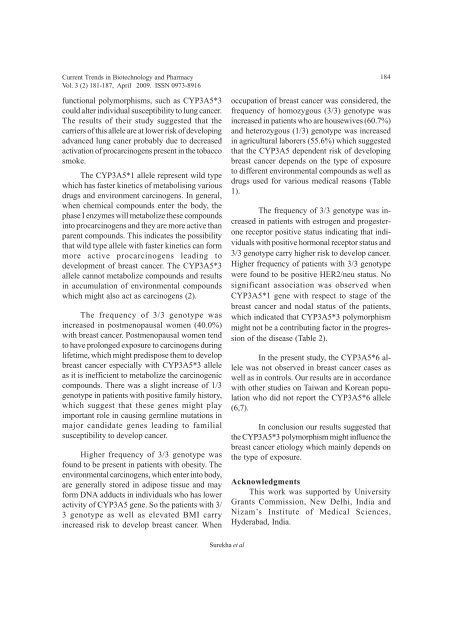April Journal-2009.p65 - Association of Biotechnology and Pharmacy
April Journal-2009.p65 - Association of Biotechnology and Pharmacy
April Journal-2009.p65 - Association of Biotechnology and Pharmacy
Create successful ePaper yourself
Turn your PDF publications into a flip-book with our unique Google optimized e-Paper software.
Current Trends in <strong>Biotechnology</strong> <strong>and</strong> <strong>Pharmacy</strong><br />
Vol. 3 (2) 181-187, <strong>April</strong> 2009. ISSN 0973-8916<br />
functional polymorphisms, such as CYP3A5*3<br />
could alter individual susceptibility to lung cancer.<br />
The results <strong>of</strong> their study suggested that the<br />
carriers <strong>of</strong> this allele are at lower risk <strong>of</strong> developing<br />
advanced lung caner probably due to decreased<br />
activation <strong>of</strong> procarcinogens present in the tobacco<br />
smoke.<br />
The CYP3A5*1 allele represent wild type<br />
which has faster kinetics <strong>of</strong> metabolising various<br />
drugs <strong>and</strong> environment carcinogens. In general,<br />
when chemical compounds enter the body, the<br />
phase I enzymes will metabolize these compounds<br />
into procarcinogens <strong>and</strong> they are more active than<br />
parent compounds. This indicates the possibility<br />
that wild type allele with faster kinetics can form<br />
more active procarcinogens leading to<br />
development <strong>of</strong> breast cancer. The CYP3A5*3<br />
allele cannot metabolize compounds <strong>and</strong> results<br />
in accumulation <strong>of</strong> environmental compounds<br />
which might also act as carcinogens (2).<br />
The frequency <strong>of</strong> 3/3 genotype was<br />
increased in postmenopausal women (40.0%)<br />
with breast cancer. Postmenopausal women tend<br />
to have prolonged exposure to carcinogens during<br />
lifetime, which might predispose them to develop<br />
breast cancer especially with CYP3A5*3 allele<br />
as it is inefficient to metabolize the carcinogenic<br />
compounds. There was a slight increase <strong>of</strong> 1/3<br />
genotype in patients with positive family history,<br />
which suggest that these genes might play<br />
important role in causing germline mutations in<br />
major c<strong>and</strong>idate genes leading to familial<br />
susceptibility to develop cancer.<br />
Higher frequency <strong>of</strong> 3/3 genotype was<br />
found to be present in patients with obesity. The<br />
environmental carcinogens, which enter into body,<br />
are generally stored in adipose tissue <strong>and</strong> may<br />
form DNA adducts in individuals who has lower<br />
activity <strong>of</strong> CYP3A5 gene. So the patients with 3/<br />
3 genotype as well as elevated BMI carry<br />
increased risk to develop breast cancer. When<br />
184<br />
occupation <strong>of</strong> breast cancer was considered, the<br />
frequency <strong>of</strong> homozygous (3/3) genotype was<br />
increased in patients who are housewives (60.7%)<br />
<strong>and</strong> heterozygous (1/3) genotype was increased<br />
in agricultural laborers (55.6%) which suggested<br />
that the CYP3A5 dependent risk <strong>of</strong> developing<br />
breast cancer depends on the type <strong>of</strong> exposure<br />
to different environmental compounds as well as<br />
drugs used for various medical reasons (Table<br />
1).<br />
The frequency <strong>of</strong> 3/3 genotype was increased<br />
in patients with estrogen <strong>and</strong> progesterone<br />
receptor positive status indicating that individuals<br />
with positive hormonal receptor status <strong>and</strong><br />
3/3 genotype carry higher risk to develop cancer.<br />
Higher frequency <strong>of</strong> patients with 3/3 genotype<br />
were found to be positive HER2/neu status. No<br />
significant association was observed when<br />
CYP3A5*1 gene with respect to stage <strong>of</strong> the<br />
breast cancer <strong>and</strong> nodal status <strong>of</strong> the patients,<br />
which indicated that CYP3A5*3 polymorphism<br />
might not be a contributing factor in the progression<br />
<strong>of</strong> the disease (Table 2).<br />
In the present study, the CYP3A5*6 allele<br />
was not observed in breast cancer cases as<br />
well as in controls. Our results are in accordance<br />
with other studies on Taiwan <strong>and</strong> Korean population<br />
who did not report the CYP3A5*6 allele<br />
(6,7).<br />
In conclusion our results suggested that<br />
the CYP3A5*3 polymorphism might influence the<br />
breast cancer etiology which mainly depends on<br />
the type <strong>of</strong> exposure.<br />
Acknowledgments<br />
This work was supported by University<br />
Grants Commission, New Delhi, India <strong>and</strong><br />
Nizam’s Institute <strong>of</strong> Medical Sciences,<br />
Hyderabad, India.<br />
Surekha et al













